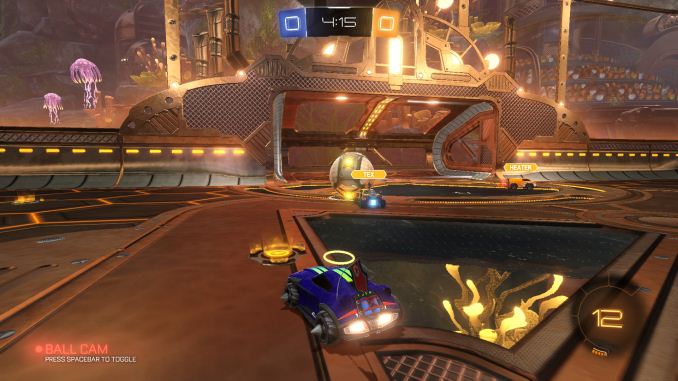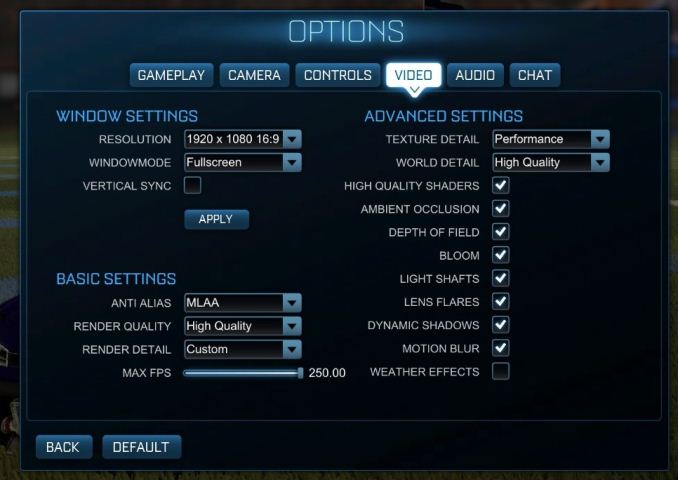Retesting AMD Ryzen Threadripper’s Game Mode: Halving Cores for More Performance
by Ian Cutress on August 17, 2017 12:01 PM ESTRocket League
Hilariously simple pick-up-and-play games are great fun. I'm a massive fan of the Katamari franchise for that reason — passing start on a controller and rolling around, picking up things to get bigger, is extremely simple. Until we get a PC version of Katamari that I can benchmark, we'll focus on Rocket League.
Rocket League combines the elements of pick-up-and-play, allowing users to jump into a game with other people (or bots) to play football with cars with zero rules. The title is built on Unreal Engine 3, which is somewhat old at this point, but it allows users to run the game on super-low-end systems while still taxing the big ones. Since the release in 2015, it has sold over 5 million copies and seems to be a fixture at LANs and game shows. Users who train get very serious, playing in teams and leagues with very few settings to configure, and everyone is on the same level. Rocket League is quickly becoming one of the favored titles for e-sports tournaments, especially when e-sports contests can be viewed directly from the game interface.
Based on these factors, plus the fact that it is an extremely fun title to load and play, we set out to find the best way to benchmark it. Unfortunately for the most part automatic benchmark modes for games are few and far between. Partly because of this, but also on the basis that it is built on the Unreal 3 engine, Rocket League does not have a benchmark mode. In this case, we have to develop a consistent run and record the frame rate.
Read our initial analysis on our Rocket League benchmark on low-end graphics here.
With Rocket League, there is no benchmark mode, so we have to perform a series of automated actions, similar to a racing game having a fixed number of laps. We take the following approach: Using Fraps to record the time taken to show each frame (and the overall frame rates), we use an automation tool to set up a consistent 4v4 bot match on easy, with the system applying a series of inputs throughout the run, such as switching camera angles and driving around.
It turns out that this method is nicely indicative of a real bot match, driving up walls, boosting and even putting in the odd assist, save and/or goal, as weird as that sounds for an automated set of commands. To maintain consistency, the commands we apply are not random but time-fixed, and we also keep the map the same (Aquadome, known to be a tough map for GPUs due to water/transparency) and the car customization constant. We start recording just after a match starts, and record for 4 minutes of game time (think 5 laps of a DIRT: Rally benchmark), with average frame rates, 99th percentile and frame times all provided.
The graphics settings for Rocket League come in four broad, generic settings: Low, Medium, High and High FXAA. There are advanced settings in place for shadows and details; however, for these tests, we keep to the generic settings. For both 1920x1080 and 4K resolutions, we test at the High preset with an unlimited frame cap.
All of our benchmark results can also be found in our benchmark engine, Bench.
MSI GTX 1080 Gaming 8G Performance

1080p



4K



Sapphire Nitro R9 Fury 4G Performance

1080p



4K



Sapphire Nitro RX 480 8G Performance

1080p



4K



With Ryzen, we encounted some odd performance issues when using NVIDIA-based video cards that caused those cards to significantly underperform. However equally strangely, the issues we have with Ryzen on Rocket League with NVIDIA GPUs seem to almost vanish when using Threadripper. Again, still no easy wins here as Intel seems to take Rocket League in its stride, but Game mode still helps the 1950X. The Time Under graphs give some cause for concern, with the 1950X consistently being at the bottom of that graph.












104 Comments
View All Comments
Ian Cutress - Saturday, August 19, 2017 - link
Visit https://myhacker.net For Latest Hacking & security updates.Glock24 - Saturday, August 19, 2017 - link
Ha your account bee hacked Ian? This seems like an out of place comment from a spam bot.zodiacfml - Saturday, August 19, 2017 - link
Useless. Why cripple an expensive chip? It is already mentioend that the value of high core counts is mega tasking, like rendering while gaming. I wouldn't be to tell a increase in of 10% or less in performance but I will do for multi-tasking.Greyscend - Saturday, August 19, 2017 - link
To summarize, I can pay $1000 for a new and crazy powerful CPU that gives me the option to turn $500 of it off so that I can sporadically gain performance in games at a level that is mostly equal to or below the level of standard testing deviations? Worth.Greyscend - Saturday, August 19, 2017 - link
I want competition in the CPU market so I feel like AMD should consider redistributing funds from what can only be described as the "Gimmicks Department" back to the actual processor R&D department. Although, the Gimmicks Department is getting pretty good at UI development. Look at the software they churned out that turns $500 of your CPU off! It's beautiful! They also seem to be getting bolder since they asked Anandtech to effectively re-write an entire article in order to more succinctly point out how consumers can effectively disable half of the CPU cores they paid for with almost no discernible real world effect. Pretty impressive considering the number of consumers who seem genuinely interested in this type of feature.Oxford Guy - Sunday, August 20, 2017 - link
"research is paramount"Yeah, like the common knowledge that Zen reviews shouldn't be handicapped by only testing them with slow RAM.
Joel Hruska at ExtremeTech tested Ryzen on day 1 with 3200 speed RAM. Tom's tested the latest batch of consumer Zen (Ryzen 3) with 3200.
And yet... this site has apparently just discovered why it's so important to not kneecap Zen with slow RAM — as if we're using ECC for enterprise stuff all the time.
Gastec - Sunday, August 20, 2017 - link
Why such abysmal performance in Rise of the Tomb Raider and GTA5 for Sapphire Nitro R9 and RX480 with Thradripper CPU's?Oxford Guy - Thursday, August 24, 2017 - link
I can't say I'm an expert on this subject but it looks like their tested games generally are a list of some of the poorer performers on AMD. Tomb Raider, GTA5, etc.Dirt 4, by contrast, shows Vega 56 beating a 1080 Ti at Tech Report.
dwade123 - Sunday, August 20, 2017 - link
Threadripper is a mess. There's always a compromise with AMD.mapesdhs - Sunday, August 20, 2017 - link
Because of course X299 doesn't involve aaany compromise at all. :D